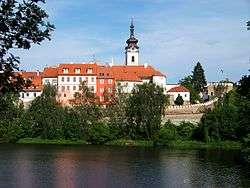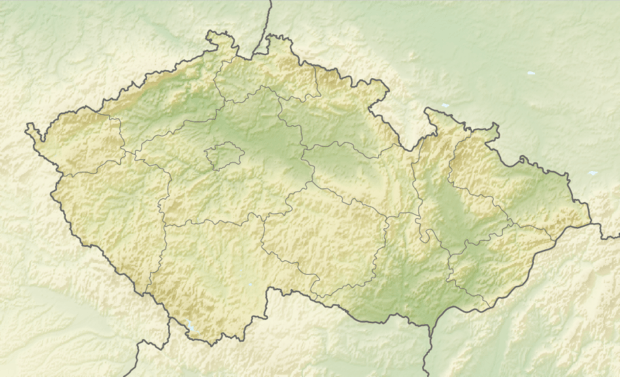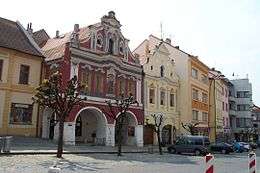Písek
Písek (Czech pronunciation: [ˈpiːsɛk]; German: Pisek) is a town in the South Bohemian Region of the Czech Republic. Písek has a population of more than 30,000 and its semi-urban agglomeration has a population of around 37,000 people.
Písek | |
|---|---|
Town | |
 Church of the Nativity of the Blessed Virgin Mary, town walls and Otava River | |
 Flag  Coat of arms | |
 Písek Location in the Czech Republic | |
| Coordinates: 49°18′32″N 14°8′51″E | |
| Country | |
| Region | South Bohemian |
| District | Písek |
| Founded | 12th century |
| Government | |
| • Mayor | Eva Vanžurová |
| Area | |
| • Total | 63.22 km2 (24.41 sq mi) |
| Elevation | 378 m (1,240 ft) |
| Population (2020-01-01[1]) | |
| • Total | 30,415 |
| • Density | 480/km2 (1,200/sq mi) |
| Time zone | UTC+1 (CET) |
| • Summer (DST) | UTC+2 (CEST) |
| Postal code | 397 01 |
| Website | www.pisek.eu |

Písek is colloquially called "Athens of Southern Bohemia",[2] because it has many high schools and schools of higher education, including the Film School in Písek. Up to the last decades of 19th century Písek was a centre of the large autonomous Prácheň Region (also Prácheňský kraj) (today's Prachatice, Písek and Strakonice Districts and parts of Příbram, Klatovy, České Budějovice and Plzeň-South Districts).
Geography
The city, spreading on slopes of several hills, sits along the river Otava. There are several steep streets and some suburbs lie more than 70–90 metres above the city centre. Much of its surroundings is covered by deciduous woodlands mixed with high number of various coniferous trees. Flow of several local brooks is slowed by artificial tiny lakes and dikes, creating mosaic of wetter and drier places, a safe haven for nesting and migrating birds.
History
This South Bohemian town was, up to its serious damage in 1620, one of the biggest towns in Bohemia. It is considered to be of prehistorical origin (first settled about 900 BC), when it was officially established as a royal city in the beginning of the 13th century - but in these times one part of to-be town had been still inhabited by descendants of German-Celtic predecessors (today's Saint Wenceslas Quarter). The oldest town in the area of modern Písek ("Písek" means "sand") was Hradiště (Oppidum on top of Hradiště hill). Close to this place remnants of two graves of Celtic kings can be found. Pisek was called Meliodunum on Ptolemaios`map of the 2nd Century - Germanic city at that time. In the 12th century, Germans were called back as settlers. Písek has still his unique atmosphere and has a well-preserved, picturesque medieval centre with number of narrow alleys. A large part of Písek encircling its city core was built in the 19th century, so one can still find there many buildings built in classical or neo-styles around tree-lined boulevards. In Písek is the oldest bridge (Písek Stone Bridge) in the Czech Republic (and the second oldest in the whole central European region).[3]
Climate
The climate in Písek is known to have a milder and drier microclimate because it is well protected from all sides against winds. Písek enjoys a cool inland version of a humid continental climate (Dfb) with rather balanced temperatures year round and rare deep negative extremes. Lying in a rainshadow causes relatively low precipitations, vastly in form of rain (539 mm/annum). There are four distinctive seasons with cold and wet winter starting in late November and ending abruptly in the first half of March, changing into much sunnier and warmer spring which ends during May. Local summer, sunny, warm and wet, then continues up to its end in the first half of September. Autumn, rapidly cooling and much drier lasts into the end of November. Weather can be highly changeable with year-round rotation of two main patterns - continental fronts, sunnier and more extreme-prone, and oceanic fronts, bringing in murkier, wetter yet equable conditions.
Average round the clock temperatures in July stay on 19.14 °C (66.45 °F) and January mean temperatures stay on −0.91 °C (30.36 °F). The whole year average is 8.98 °C (48.16 °F). The town is sunnier than its wind-prone high-grounded vicinity with some 1,750 hours of sunshine with the most sunlight occurring between March and September, and murky period between November–January. While last spring frost was recorded on May 18 and the first autumn frost was recorded on 18 September, i.e. 121 days without any frost [33.13% of the year], most years have frost-free period between early-April until mid of October [6+ months].
Extreme cold weather has reached -22.9 °C and extreme hot +42.0 °C.[4] Písek falls into 7a zone according to USDA zoning with average year absolute minimal temperature at −16.4 °C (2.5 °F) and into AHS heat zone 4 with only 15 days annually with temperatures crossing 86 °F (30 °C) - normal year has maximal temperature of 34.83 °C (94.69 °F). Nevertheless, number of days with at least 25 °C (77 °F) is normally 56 per a year. Písek has typically great differences between daily minimal and maximal temperatures due to its position far inland.
Písek is shielded from the northeastern winds by the Písek Mountains (poetically called the Gem Mountains) whose highest peak 633 metres (2077 feet) high is located 5 kilometres to southeast from Pisek. Otava river, still bearing the ancient Celtic name, flows through the city and the lowest point is located on its shores (350 metres ASL, 1148 feet).
| Písek | ||||||||||||||||||||||||||||||||||||||||||||||||||||||||||||
|---|---|---|---|---|---|---|---|---|---|---|---|---|---|---|---|---|---|---|---|---|---|---|---|---|---|---|---|---|---|---|---|---|---|---|---|---|---|---|---|---|---|---|---|---|---|---|---|---|---|---|---|---|---|---|---|---|---|---|---|---|
| Climate chart (explanation) | ||||||||||||||||||||||||||||||||||||||||||||||||||||||||||||
| ||||||||||||||||||||||||||||||||||||||||||||||||||||||||||||
| ||||||||||||||||||||||||||||||||||||||||||||||||||||||||||||
| Climate data for Pisek | |||||||||||||
|---|---|---|---|---|---|---|---|---|---|---|---|---|---|
| Month | Jan | Feb | Mar | Apr | May | Jun | Jul | Aug | Sep | Oct | Nov | Dec | Year |
| Record high °C (°F) | 15.1 (59.2) |
18.8 (65.8) |
24.6 (76.3) |
32.4 (90.3) |
33.3 (91.9) |
39.3 (102.7) |
42.0 (107.6) |
41.5 (106.7) |
38.3 (100.9) |
25.6 (78.1) |
20.6 (69.1) |
15.3 (59.5) |
42.0 (107.6) |
| Average high °C (°F) | 1.1 (34.0) |
2.8 (37.0) |
8.3 (46.9) |
13.7 (56.7) |
19.0 (66.2) |
21.9 (71.4) |
23.9 (75.0) |
23.4 (74.1) |
19.3 (66.7) |
13.1 (55.6) |
6.2 (43.2) |
2.6 (36.7) |
12.9 (55.3) |
| Daily mean °C (°F) | −2 (28) |
−0.9 (30.4) |
3.6 (38.5) |
8.1 (46.6) |
13.1 (55.6) |
16.2 (61.2) |
18 (64) |
17.6 (63.7) |
13.8 (56.8) |
8.4 (47.1) |
3.1 (37.6) |
−0.1 (31.8) |
8.2 (46.8) |
| Average low °C (°F) | −5.1 (22.8) |
−4.5 (23.9) |
−1.1 (30.0) |
2.6 (36.7) |
7.2 (45.0) |
10.5 (50.9) |
12.1 (53.8) |
11.8 (53.2) |
8.3 (46.9) |
3.8 (38.8) |
0.0 (32.0) |
−2.8 (27.0) |
3.6 (38.4) |
| Record low °C (°F) | −19.7 (−3.5) |
−22.9 (−9.2) |
−11.4 (11.5) |
−5 (23) |
−1.9 (28.6) |
2.4 (36.3) |
5.6 (42.1) |
3.8 (38.8) |
−1.2 (29.8) |
−4.4 (24.1) |
−9.6 (14.7) |
−18.1 (−0.6) |
−22.9 (−9.2) |
| Average precipitation mm (inches) | 41 (1.6) |
37 (1.5) |
41 (1.6) |
43 (1.7) |
74 (2.9) |
83 (3.3) |
89 (3.5) |
79 (3.1) |
55 (2.2) |
41 (1.6) |
42 (1.7) |
47 (1.9) |
672 (26.5) |
| Source 1: [6] | |||||||||||||
| Source 2: [7] | |||||||||||||
Main sights
.jpg)
- Church of the Nativity of the Blessed Virgin Mary (Kostel Narození Panny Marie)
- Church of Holy Trinity (Písek)
- Church of the Elevation of the Holy Cross (Písek)
- Marian column
- Písek Castle
- Prácheňské museum
- Stone Bridge (Kamenný most)
Transport
Písek is connected by the D4 motorway to Prague and by the I/20 and I/29 highways. The I/20 travels northwest to Plzeň and southeast to České Budějovice, while the I/29 travels east to Tábor.
Písek railway station lies on the Zdice–Protivín and Tábor–Ražice rail lines. The Plzeň-České Budějovice line passes through nearby Ražice.
Notable people
- Ottokar II of Bohemia (c.1233–1278), king of Kingdom of Bohemia
- Adolf Heyduk (1835–1923), poet
- August Sedláček (1843–1926), historian
- Otakar Ševčík (1852–1934), violinist
- Josef Holeček (1853–1929), writer
- Fráňa Šrámek (1877–1952), writer and poet
- Jan Mukařovský (1891–1975), literature theorist
- John Juzek (1892–c.1965), exporter of orchestral string instruments
- Ferdinand Hart (1893–1937), actor
- George Mraz (born 1944), bassist
- Kateřina Neumannová (born 1973), cross-country skier
- Tomáš Zíb (born 1976), tennis player
- Tomáš Verner (born 1986), figure skater
Twin towns – sister cities
.svg.png)





Friendly town

References
- "Population of Municipalities – 1 January 2020". Czech Statistical Office. 30 April 2020.
- "Town of Písek". www.visitpisek.cz. Retrieved 30 October 2017.
- "Stone Bridge". visitpisek.cz. VisitBohemia. Retrieved 27 July 2020.
- Jakub Wailguny. "Meteorologická stanice SZEŠ Písek". Czv.szespisek.cz. Archived from the original on 7 July 2015. Retrieved 18 August 2015.
- "Amut.Net data for Pisek, CZE". Retrieved 9 October 2015.
- "Climate: Písek". Climate-Data.ORG. Retrieved 10 September 2015.
- "Písek, Czech Republic". Wunderground.com. Retrieved 2 April 2017.
- "Partnerská města" (in Czech). Město Písek. Retrieved 23 August 2019.
External links
![]()
| Wikivoyage has a travel guide for Písek. |
- Official Website (in English, Czech, and German)
- Písek (en)
- Online webcam in the center of Písek
- Road map of South Bohemia